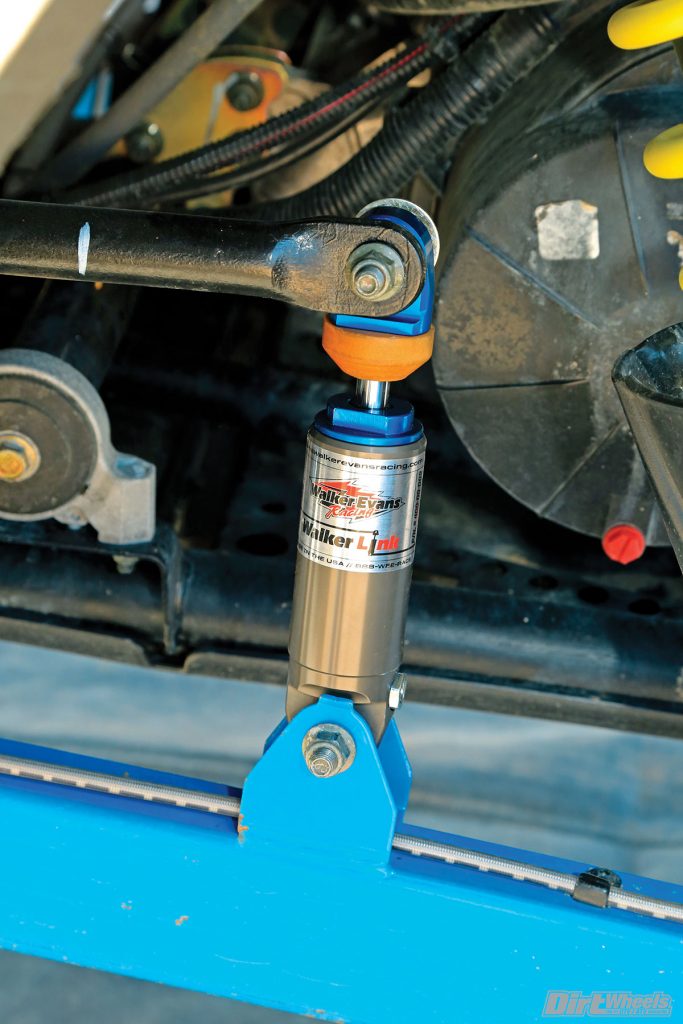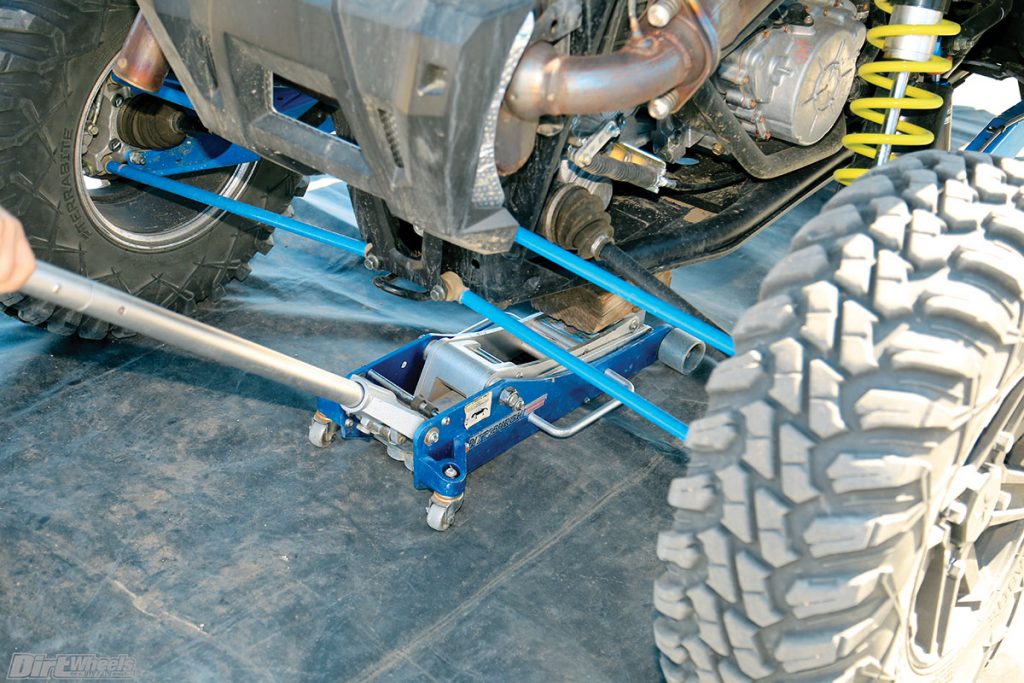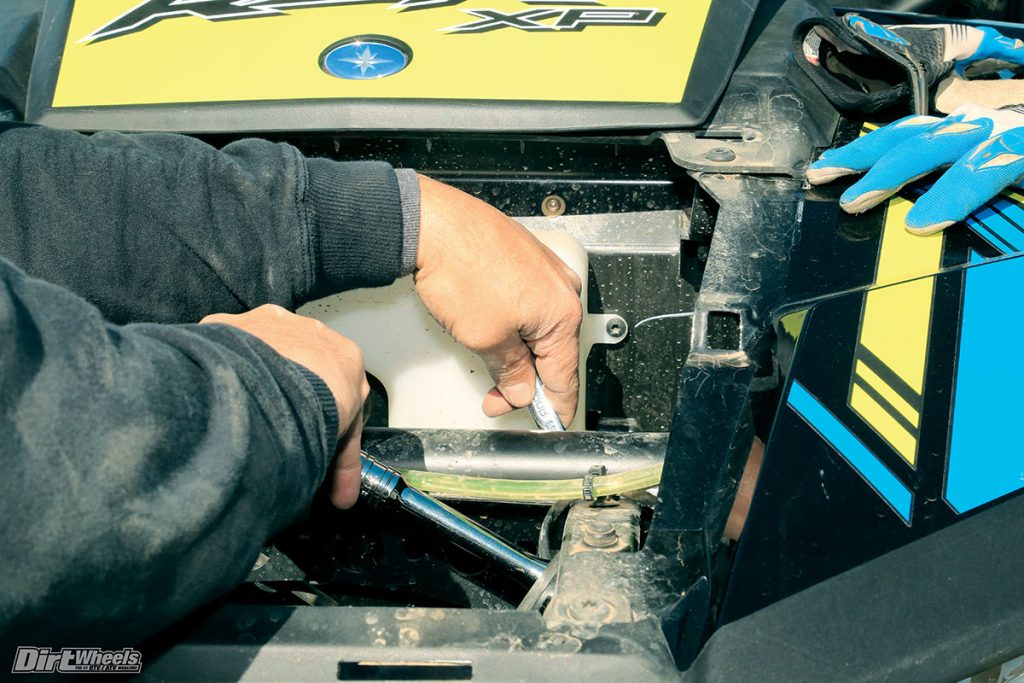SUSPENSION SETUP TIPS:
— TESTING WALKER EVANS STEP-BY-STEP SHOCK TUNING —
Improve your UTV without wasting money,
By the staff of Dirt Wheels —
A lot of UTV owners don’t realize just how crucial suspension and shocks are to any machine. The difference between old worn-out shocks and freshly maintained ones is huge in terms of comfort, performance and handling. The suspension feels great on a new UTV, but the shock action deteriorates with use. It happens slowly, so you might not notice the change. The shock body itself shouldn’t wear out unless it is abused or not serviced. Parts like the seals, piston bands, shims, shock fluid and even the springs do wear with use. For general sporting use, Walker Evans tech Reid Nordin suggests that the suspension be serviced at 1500 miles. That number goes down with extreme use and can go up with mild use. By the time the suspension is ready for service, the stock springs can be worn out. For our test, we started with a Polaris RZR XP 1000 with approximately 200 miles on it. It basically has no added weight in added parts, but the ride height had already settled a half inch from stock. To correct that, we added preload. Polaris specifies in the manual that no more than 25mm of preload may be added to the springs. We can see that 1500 miles could easily put us over that number, and that would require new springs.

When your suspension needs service, you have two options: the least expensive route is to service your shocks, or you can put more cash down for higher-performing shocks. We recently spent time testing shock setups with Walker Evans Racing (WER) out in the harsh desert terrain of Barstow in Southern California.

WER’s Reid Nordin brought out a few different shock options for our Polaris, along with a set of Walker Links, which are hydraulic sway bar links. After setting the preload of our stock shocks, we found a 20-minute loop in the desert consisting of giant whoop sections and rocky, rutted and sandy terrain with a few flat dirt roads to rip down.

RIDE HEIGHT AND LINKS
In our “Basic Suspension Setup Secrets” article from the June 2017 issue of Dirt Wheels, we covered the importance of setting the correct shock preload and when it was time to maintain them. Reid set the ride height of our RZR shocks and sent us out on a loop. We didn’t realize how much the springs had weakened after a few hundred miles. The car had a spring in its step again and didn’t bottom out as easily.

The first upgrade after the ride-height adjustment was the installation of the WER rear sway bar links that they call the Walker Link. A pair of links is $375. Each link acts like a shock absorber and provides 1.5 inches of damping action. The links allow the UTV to have some suspension in the sway bar to free up the wheel action compared to the stock links that are rigid aside from rubber-bushed eyes.

The RZR tracked a lot better in corners with more stability, and instead of the machine trying to lift the inside wheels in turns, the rear tires slid in the dirt, which provided confidence in corners. Over whoop sections the rear end tracked straighter and wouldn’t try to swap on us.

SHOCK UPGRADE: STAGE 1
Walker Evans Racing provides a shock service for your stock WER shocks. Our Polaris came stock with WER shocks with single, progressively wound springs in the front and dual-rate springs without crossover rings in the rear. All you have to do is ship your shocks to them, and they will fully service the shocks with new seals, bands and fluid. In most cases they will adjust the internal shock setting for your machine and intended use and terrain. They will also change out the old springs with higher-quality Eibach springs that have a better dual-rate setup with crossover rings. Nordin removed our stockers and put a set of rebuilt and modified stock shocks on, then he sent us out on another loop through the harsh desert terrain.

We felt the improvement instantly! The copilot kept an eye on our speeds, and we increased driving speed in every section by 5 to 10 miles per hour. The shocks were more resistant to bottoming, and there was smoother action through the stroke of the shock over stock. The downside to this setup, which is still much better than the stock shocks, is that they were a little harsher over slow-speed chop. We had asked for better sport performance, however, that can be adjusted in the shocks to suit the terrain you ride in. After about an hour of hard driving, you can feel the front 2.0 shocks start to fade. This shock service stage will run you $1400 for all four shocks. That includes the springs but not the parts and oil.
SHOCK UPGRADE: STAGE 2.5
The next change was to replace the 2.0 front shocks. Nordin installed 2.5 reservoir needle shocks that have a larger body, shock shaft and reservoir, in addition to adjustable dual-compression damping. There is a greater volume of shock fluid, and a larger piston offers improved damping control over the stock 2.0s. The 2.5s are designed to be more resistant to bottoming out as well with progressively stiffer damping. A large tapered needle in the shock body inserts into the hollow shock shaft as the shock nears the end of the shock stroke. The needle gradually restricts the oil flow through the shaft and forces it through the shock piston for more and better controlled damping.
The increase in oil helps the shocks not fade as quickly and perform stronger longer. A crossover ring is installed on these shocks, which allows the shock to perform better. The (softer) top spring in the dual-rate spring setup will compress first, and the crossover ring starts the second spring compressing before the smaller spring is completely compressed. Each shock costs $677.93, but with this setup, you only pay for the rear shocks to be modified at $700. The total is $2055.86 (without the Walker Links). We got the 2.5s installed.
It was time to take another loop. The difference in shocks was very noticeable in all terrain. The 2.5s allowed our speeds to increase again, and we pushed the RZR harder through the whoops and were impressed. The front shocks soaked up hard hits without putting as much feedback to the steering wheel. We didn’t feel our brains trying to scramble over chop, and the 2.5s in the front complemented the rear shocks. The Polaris didn’t bottom out nearly as hard as before, and the new front shocks kept up for miles without a hint of fading. The springy feeling that we got from the 2.0s was lessened. If you don’t plan to race your machine and want a setup that works great and is worth every penny, this combination is the way to go.

SHOCK UPGRADE: STAGE VELOCITY
Walker Evans Racing didn’t mess around when they designed its Velocity shocks. These billet-aluminum-bodied, hard-anodized, dual-rate shocks are re-valvable and re-buildable. The reservoirs are specifically positioned on the shock bodies to allow a better oil flow that provides a more controlled and higher resistance to bottoming. Unlike the other shocks, the rear shocks have piggyback reservoirs to eliminate the possibility of the reservoir hose failing in extreme use.
Adjusters on the reservoir provide low- and high-speed compression adjustment. These shocks use an advanced-version of WER needle-valve technology to provide multiple stages of internal bypass. The shock needle has five machined flats of varying lengths machined in. As the needle inserts into the shock shaft, the damping increases as each flat ends, so the final part of the travel has extremely progressive damping increases. There are other needles available, with three or two flats for extreme uses like desert racing. Each shock runs $899.99 for our RZR XP 1000, and for a true competitor or hardcore trail rider they are worth the cost.
Nordin installed all four Velocity shocks on our Ride Command, and away we went back into the desert. The change was almost unreal compared to the stock shocks, and you could feel the improvements over the 2.5 shocks from the previous stage. The RZR felt planted in corners, through rocks and over whoops. Cornering was less wallowy, and we had more control over the machine. The RZR tracked straighter in deep whoops, and bottoming out was no sweat compared to the backaches we got from the stock shocks. We could tune out the rough ride in slow-speed chop and tune the Velocity shocks to skip the top of whoops with ease. The total cost here was $3600.
FINAL THOUGHTS
It is crazy to think that such a dramatic change in suspension could occur for the reasonable pricing that Walker Evans Racing offers on their shocks and shock upgrades. If you have been driving your UTV for a year or more, then it is time to service your suspension or, even better, purchase some new shocks. Our speeds and fun increased to the point where we no longer trusted the stock seat belts and roll cage! Go to www.walkerevansracing.com or call (888) 933-7223 to get a set of shocks and links or to upgrade your existing Walker Evans Racing shocks.




Comments are closed, but trackbacks and pingbacks are open.